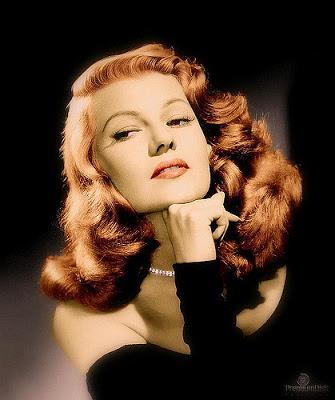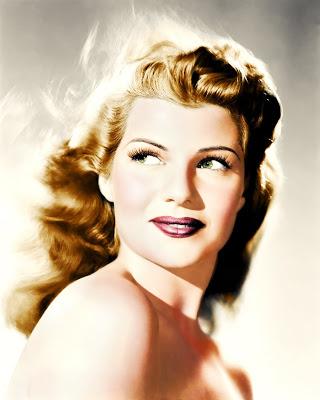
The legend of Rita Hayworth has it that her mother, formerly of the Ziegfeld Follies, wanted her daughter to be an actress, but her father, a professional dancer, wanted the girl to be a dancer. Eduardo Cansino, her dad, won out and little Margarita Carmen Cansino would begin to dance at age three.
She was born on October 17, 1918 – one hundred years ago – in Brooklyn. At age four, as a member of the family act, the Four Cansinos, she was on stage and dancing at the Winter Garden Theatre in a Broadway production of The Greenwich Village Follies. Eduardo Cansino believed that the movies needed more professional dancers and so, in 1926, the Cansinos moved to Hollywood.
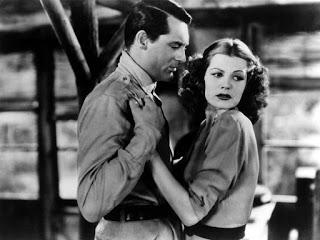
Cary and Rita in Only Angels Have Wings (1939)
By the late ‘30s, Margarita, first known as Rita Cansino, then Rita Consuelo and finally Rita Hayworth, had gone solo and was now a young actress on the rise. Under contract to Columbia Pictures, she would make her way up the Hollywood ladder and undergo a dramatic transformation along the way.In 1939 she began to break out with a supporting role, that of “Judy, Judy, Judy,” in Columbia’s Only Angels Have Wings starring Cary Grant and Jean Arthur. Though Columbia’s thorough makeover of her appearance, style and voice had barely begun, she was on her way to becoming the studio's first top-tier glamour girl.
In 1940, on loan to Warner Bros., she appeared in alongside James Cagney and Olivia de Havilland in The Strawberry Blonde. But it was her performance, again on loan, for 20th Century Fox’s Blood and Sand (1941) opposite Tyrone Power that established her as a bona fide sex symbol. In the film it is Rita’s character, Doña Sol, whose callous treatment of Spain’s top matador (Power) is the catalyst for his downfall. Confirming her credibility as an irresistible siren were reports from the set that Tyrone Power, a formidable sex symbol in his own right, was so fascinated by Miss Hayworth that he could barely take his eyes from her during filming.
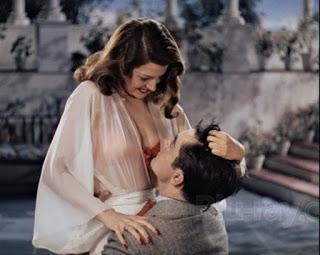
Rita and Tyrone Power in Blood and Sand (1941)
Rita Hayworth’s metamorphosis was just about complete, she was a certified movie star and a #1 pin-up girl of World War II. But it wouldn’t be until the war’s end that she would step into the role that would forever define her and signal the very peak of her career.Gilda (1946) is a burnished-looking noir with a bitter aftertaste from Hayworth’s home studio, Columbia Pictures. The film’s high contrast gloss, mostly thanks to Rita’s glamorous turn as the wayward Gilda and cinematographer Rudolph Maté, is offset by its perverse undercurrents. Hatred seems the prime motivator behind the actions of more than one central character…“Hate can be a very exciting emotion. Very exciting. Haven’t you noticed that?” And, with all that hate in the ether, it's no surprise that a profoundly twisted triangle develops between the three main characters.
Gilda opens with two-bit gambler Johnny Farrell (Glenn Ford) in the middle of a game of dice, reduced to trying his luck in “the Argentine.” Chance soon throws him together with casino owner Ballin Mundson (George Macready) when the older man rescues him from an even more dicey situation. The two hit it off and soon Johnny is managing Mundson’s casino. Things get tricky when Johnny discovers that Mundson’s much younger new wife is his ex, a hair-tossing night club singer/dancer named Gilda. Barbs fly back and forth between the two former flames for most of the rest of the film. Yes, hate can be exciting, if that’s what you want to call it. Some would simply say, “warped desire.”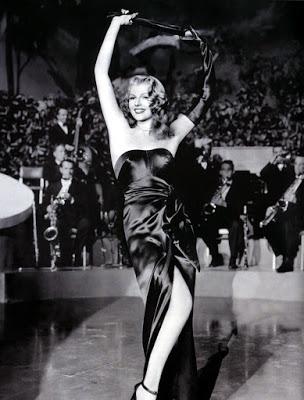
Rita as Gilda
By the time Gilda was released in early 1946, Rita Hayworth's makeover was complete and she was now every inch a sultry "Love Goddess." Her hair was a free-flowing, red-tinged riot with her hairline raised to open up her face. She was clad in gowns designed by Jean Louis, and her dance routines were the work of Jack Cole, the man who would concoct Marilyn Monroe's "Diamonds are a Girl's Best Friend" number a few years later. Additionally, casting Rita opposite Glenn Ford proved to be a canny move. Ford's Johnny Farrell was generically sullen, with a chip on his shoulder and a scowl embedded on his face - a worthy foil to Gilda's languid and world-weary seductress.The film was a smash and Rita would reign with the likes of MGM's Ava and Lana as an international movie star and object of global desire. With the passage of years, though, she would grow to rue the impact of her superstar-making role on her private life. More than once she famously remarked that the men in her life all seemed to "...fall in love with Gilda and wake up with me."
Rita Hayworth's late years were difficult but that's something to explore at another time, perhaps. Today we celebrate her 100th centenary, recalling her best-remembered film and her sizzling portrayal of Gilda. Rita is also being honored all this month as TCM's Star of the Month for October (click here for more plus a schedule) - and I'll be watching her on the big screen tonight as my local movie house, the Smith Rafael Film Center (aka/the Rafael), pays tribute with a one-night-only screening of Gilda.
